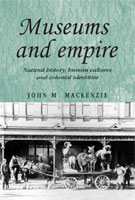
For many years, tourists visiting the island nation of Fiji found the national museum conveniently sited in the centre of the capital, its portico and columns a silent guide to the British colonial influence that inspired its origins. Visitors might reflect on the nearness of the museum to the buildings of colonial power, administration and justice. Today, a handsome new building graces the Thurston Gardens, near the Presidential Palace. But memory serves as a reminder. Not for the first time would a national museum be built and reside comfortably within reach of government buildings; nor for the last time, would a colonial museum, once a metonym for empire itself, become a symbol of national power.
In this important book, possibly the first to offer an overview of the 'museum idea' as it evolved throughout the British Empire, Professor MacKenzie charts a voyage of discovery, exploring the means by which the 'idea' took hold and flourished as both an embodiment of imperial authority and an expression of colonial pride. Although he does not write about Fiji, he might have done so, as his message reaches to the extremities of British influence. The message is not new — many have written of the close association between objects, artefacts and the politics of knowledge — but it is nonetheless compelling; and in his company, the imperial traveller crosses two centuries and five continents, surveying in 11 chapters the settler colonies of Canada, South Africa, Australia and New Zealand, with a long sidelong glance at British influence in Asia. In so doing, the traveller comes to appreciate the ways in which the colonial museum — and museum knowledge — helped condition, define, and manage empire, both at Home and at the periphery.
Colonial museums — like the international exhibitions that so often gave them rise, and the metropolitan museums on which they were modelled — were not merely idiomatic emblems of global expansion; they were also monuments of enterprise, visual encyclopedias, offering both moments of spectacle and objects of display. Ideally, they symbolised, in John Ruskin's visionary phrase — which MacKenzie quotes — 'the manifestation of what is lovely in the life of Nature and heroic in the life of Men'. No less important to the objective study of nature, for TH Huxley, they offered the experience of 'recreation by wonder'. But, as MacKenzie notes, the imperial impulse — nowhere codified but everywhere understood — produced differing results in different places. Tracing their evolution, he sets out in five stages the way in which colonial museums, born of local pride and ambition, attuned to local economic and social development, gradually became more specialised and scientific and, eventually, more self-reflective as well. By the twentieth century, they had begun giving greater space to the living cultures of Indigenous peoples, while still asserting the values of colonial character. Today, if the tourist gaze seems to dominate, these museums celebrate over 150 years of compromise between objectives and resources. If it is true that people now circulate more regularly than things (p. 269), national museums that MacKenzie sees arising from colonial foundations have shown themselves remarkably capable of reforming, refocusing and adapting to the circumstances of national life.
The story MacKenzie tells is for the most part satisfyingly Victorian and progressive. His comparative treatment of the Royal Ontario Museum, the Royal British Columbia Museum (Victoria), the South African Museum in Capetown, and the Albany Museum in Grahamstown, the War Memorial Museum in Auckland and the Canterbury Museum in Christchurch brings new information and insight to Australian readers. And if his readings of museum history in Sydney, Melbourne and Adelaide do not always reflect our most recent scholarship, his success in 'putting a girdle round the earth' remains impressive. The reader comes away with a rounded sense of the way in which colonial museums promoted the 'raiding' as well as the 'reading' of nature, instilling habits of collection and classification that were closely bound up with the practices of British imperialism. At the same time, MacKenzie perhaps does not stress quite enough the role that the same museums played in instilling a sense of national sovereignty. Before a nation can become truly sovereign, it must know itself. And as self-knowledge brings a sense of nationhood, natural history becomes national history. Eventually, that history makes museums a source of national pride and international recognition.
Today, national museums throughout the Commonwealth differ widely in size, wealth, breadth and depth, but all have come increasingly to share common professional goals and methods. Many still experience a great difficulty — at which MacKenzie hints, but for which no one has yet found a remedy — in bringing an institution that was conceived in Antiquity, nurtured in the West, and appropriated by European empires, into the working lives of Indigenous people in Asia, the Americas, the Middle East, Africa and the Pacific. For too long, the 'museum idea' treated peoples as objects, and their traditional practices as historical artefacts. It is little wonder that museums remained for so long the preserve of the white societies that gave them birth. To change their status and function, so as to meet the needs and expectations of peoples whose lives they hold in trust, remains one of the greatest challenges awaiting the museum community today. We can be grateful to Professor MacKenzie for reminding us of both historical provenance and future promise.
Roy MacLeod is emeritus professor of history, School of Philosophical and Historical Inquiry, University of Sydney.
